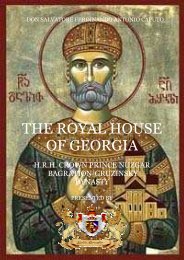here - Nobility Associations
here - Nobility Associations
here - Nobility Associations
You also want an ePaper? Increase the reach of your titles
YUMPU automatically turns print PDFs into web optimized ePapers that Google loves.
force, who were often forced to eat their own horses, or, as legend has it, the bodies<br />
of their fellow Christians who had not survived.<br />
Bohemond convinced a guard in one of the towers, an Armenian and former<br />
Christian named Firouz, to let the Crusaders enter the city. He did so on June 3,<br />
1098, and a massacre of the Muslim inhabitants ensued.[citation needed] Only four<br />
days later, a Muslim army from Mosul, led by Kerbogha, arrived to besiege the<br />
Crusaders themselves. Alexius I Comnenus, the Byzantine emperor, was on his way<br />
to assist the Crusaders; but upon hearing rumors that the city had fallen to the<br />
Muslims, Alexius turned back.<br />
The Crusaders withstood the siege, with help from a mystic named Peter<br />
Bartholomew. Peter claimed he had been visited by St. Andrew, who told him that<br />
the Holy Lance, which pierced Christ's side as he was on the cross, was located in<br />
Antioch. The cathedral of St. Peter was excavated, and the Lance was discovered by<br />
Peter himself. Although Peter most likely planted it t<strong>here</strong> himself (even the papal<br />
legate Adhemar of Le Puy believed this to be the case), it helped raise the spirits of<br />
the Crusaders.[citation needed] With the newly discovered relic at the head of the<br />
army, Bohemond marched out to meet the besieging Muslim force, which was<br />
miraculously defeated — as according to the Crusaders, an army of saints had<br />
appeared to help them on the battlefield.<br />
T<strong>here</strong> was a lengthy dispute over who should control the city. Bohemond and the<br />
Italian Normans eventually won, and Bohemond named himself prince. Bohemond<br />
was already Prince of Taranto in Italy, and he desired to continue such<br />
independence in his new lordship; thus he did not attempt to receive the title of<br />
Duke from the Byzantine Emperor (in whose name he had taken an oath to fight),<br />
nor any other title with deep feudal obligations.<br />
Prince of Antioch<br />
Our history of Antioch of our family begins with Federico (Frederick) of Antioch d'<br />
Hauteville von Shwaben Hohenstaufen son of the Emperor Frederick II of Swabia<br />
and t<strong>here</strong>fore a descendant of Frederick I Barbarossa. Born in Palestine in 1228, to<br />
Maria Matilde (or Beatrice) of the House of the princes Bohemond of Antioch of<br />
Altavilla (Hautville) and Constance, daughter of Philip I, King of France. The<br />
House of Antioch has origin Italo-German-French. Bohemond of Altavilla, son of<br />
Robert Guisgardo (Guiscard). Bohemond conquered Antioch in the first crusade on<br />
June 3, 1098, of which he was appointed prince. Federico of Antioch married the<br />
noble roman Margherita Poli, daughter of Giovanni of Poly Romano; t<strong>here</strong>fore<br />
Margherita was nephew of Pope Innocent III.<br />
The Hohenstaufen Dynasty - Page 118 of 200



